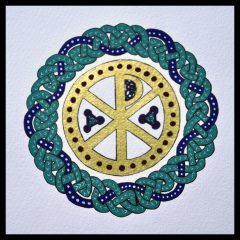
For a printable copy of this chapter (7) click here: 8.5×11″; A4 paper
Click here for a pdf of Genesis 4–11 in Redemptive History: 8.5×11″; A4 paper
.
.
e) Rev 19:16: John’s description of the rider on the white steed in Rev 19:11–16 concludes by saying, “And he has on his robe and on his thigh a name which had been inscribed, ‘King of kings and Lord of lords.’
Where exactly this title appears causes some controversy among commentators.[1] Is it written in two places or on only one?[2]
Fortunately, Greek grammar assists us here. The word which we usually translate as “and” (kai) can also mean “that is” or “namely.”[3]
As a result, we can be translate this clause as, “And he has on his robe, namely, on his thigh, a name….”
When astride a horse, a person’s thighs present prominently, making them appropriate places for an exalted title. Warriors also hung their swords from their thighs (Exod 32:27; Judg 3:16).[4]
In addition, someone taking an oath would place a hand under the thigh of the one receiving the promise (Gen 24:2–4; Gen 47:29–31).
Therefore, this detail in Revelation symbolizes that Jesus’s victory over evil will fulfill the Lord’s promise to judge the wicked.[5]
John’s original audience would have recognized this imagery.[6] The second century AD geographer Pausanius wrote this about a statue he saw:
The offering of the Mendeans in Thrace came very near to beguiling me into the belief that it was a representation of a competitor in the pentathlum …It holds ancient jumping-weights. A…couplet is written on its thigh, “To Zeus, king of the gods, as first-fruits was I placed here.”[7]
.
.
Written on the messiah’s thigh, an inscription says: “King of kings and Lord of lords.”
In the Old Testament, that title applied to Yahweh as the supreme ruler (Deut 10:16–18; Ps 136:1–3; Dan 2:47).[8]
Jewish apocryphal books also applied this term only to God. For example, 1 Enoch (2nd century BC–1st century AD) says:
Then they said to their Lord, the King, Thou art Lord of lords, God of gods, King of kings. The throne of thy glory is for ever and ever, and for ever and ever is thy name sanctified and glorified. Thou art blessed and glorified. Thou hast made all things; thou possessest power over all things; and all things are open and manifest before thee…Nothing can be concealed from thee.[9]
Plutarch (ca. 45–125 AD), noted that the Roman ruler Pompey “would not deign, in answering a letter from the king of Parthia, to address him as King of Kings, which was his usual title.”[10]
People within the Ancient Near East also applied that title to human kings (Dan 2:36–38; Ezek 26:7; Ezra 7:12).[11]
The Lord overturned the claim of King Nebuchadnezzar (534–562 BC) to the title King of kings (Dan 4:30–37). Even so shall Christ overthrow the beast of Revelation (Rev 13:1–2; Rev 19:20).[12]
Here “King of kings and Lord of lords” applies to Christ, rather than referring strictly to Yahweh (Cf. Rev 17:14).[13] Ultimately, Jesus rules over all the kings on the earth (Phil 2:9–11; Rev 1:5).[14]
Everyone will see this when he triumphs over all his enemies.[15]
Image via Wikimedia Commons
.
Read Rev 19:16. What is the significance of the inscription on the rider’s thigh? How does the photograph of a Hungarian crown illustrate this truth?
.
.
Go to The Great Supper of God (Rev 19:17–19)
[Related posts include Faithful and True (Rev 19:11); Ruler of All Nations (Rev 19:12–13); The Armies in Heaven (Rev 19:14); Striking the Nations (Rev 19:15); The Great Supper of God (Rev 19:17–19); Cast into the Inferno (Rev 19:20–21); The Waters Prevail (Gen 7:17–20); The Breath of Life Extinguished (Gen 7:21–24); The Name Above Every Name (Phil 2:9–11); and Ancient Literature]
[Click here to go to Chapter 7: God Opens the Heavens and the Earth (Genesis 7:1–24)]
.
[1]Aune, Revelation 17–22, 1062.
[2]Beale, The Book of Revelation: A Commentary on the Greek Text, 963.
[3]Arndt, Danker, and Bauer, “και” (kai), BDAG, 494–6, 495.
[4]Mounce, The Book of Revelation, 356.
[5]Beale and McDonough, “Revelation,” Commentary on the New Testament Use of the Old Testament, 1144.
[6]Keener, Revelation, 455.
[7]Pausanias, Description of Greece (trans. W. H. S. Jones and H. A. Ormerod; Cambridge, MA: Harvard University Press, 1918), 5.27.12, http://www.perseus.tufts.edu/hopper/text?doc=Perseus%3Atext%3A1999.01.0160%3Abook%3D5%3Achapter%3D27%3Asection%3D12. I had the privilege of seeing a similar statue of an athlete in the exhibition The Greeks.
[8]Mounce, The Book of Revelation, 356.
[9]Charles, trans., “Book of Enoch,” in The Apochrypha and Pseudepigrapha of the Old Testament, 9:4–6, 21, http://archive.org/stream/cu31924067146773#page/n135/mode/2up. Italics mine.
[10]Plutarch, “Pompey,” in Plutarch’s Lives (trans. Bernadotte Perrin; Cambridge, MA: Harvard University Press, 1917), 38.2, http://www.perseus.tufts.edu/hopper/text?doc=Perseus%3Atext%3A2008.01.0058%3Achapter%3D38%3Asection%3D2.
[11]Keener, Revelation, 454.
[12]Beale, The Book of Revelation: A Commentary on the Greek Text, 963–4.
[13]Aune, Revelation 17–22, 1062–3.
[14]Keener, Revelation, 454–5.
[15]Mounce, The Book of Revelation, 356.
